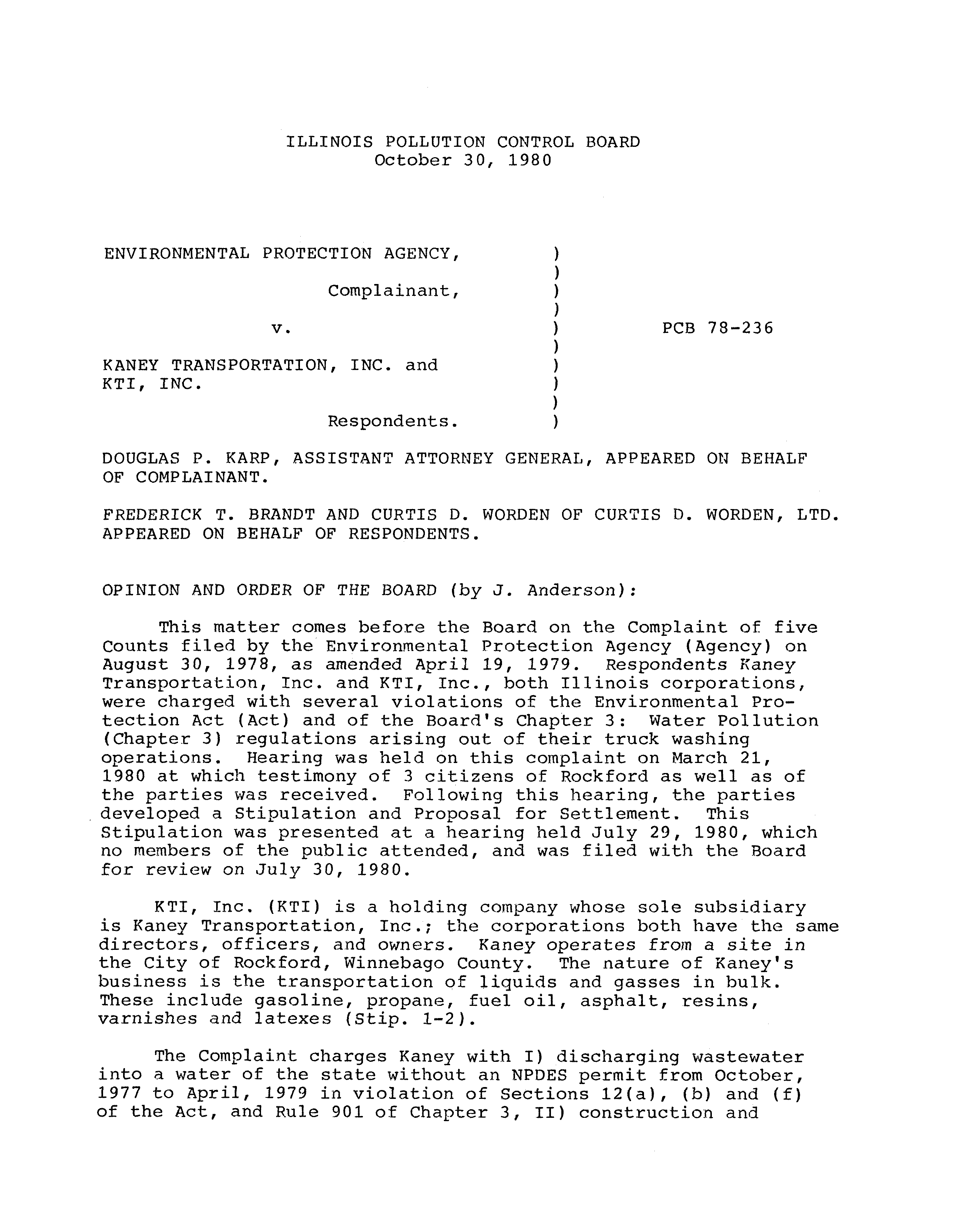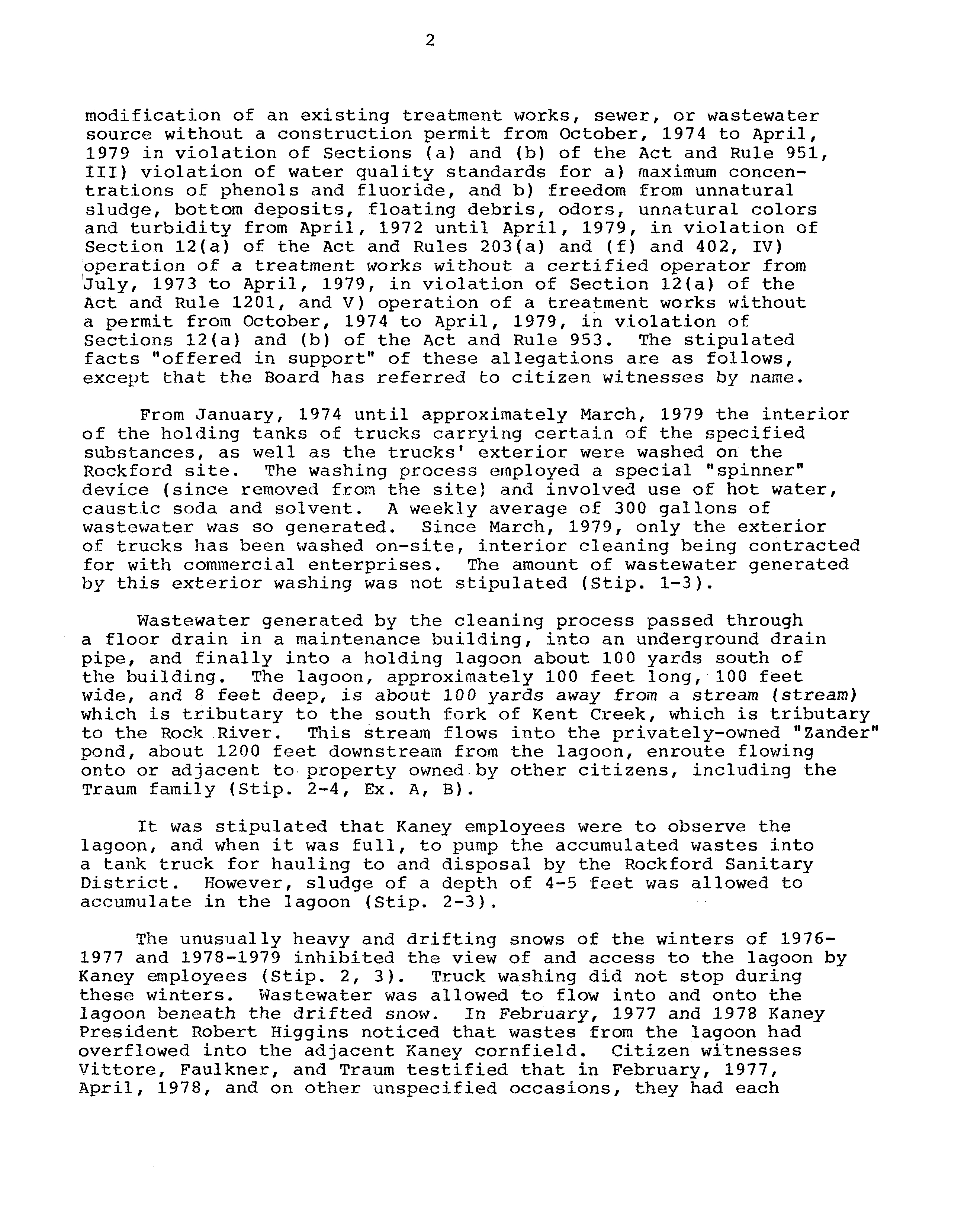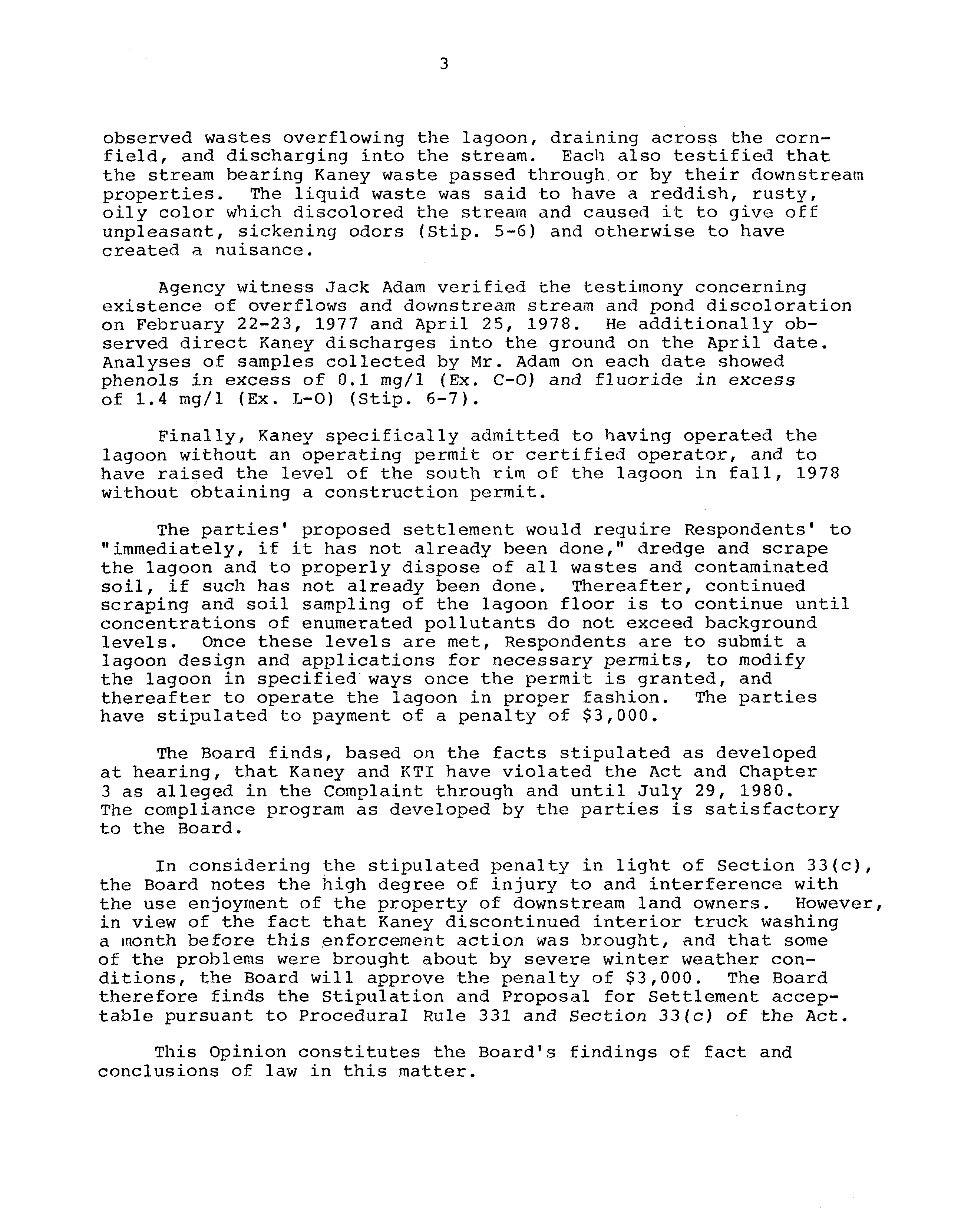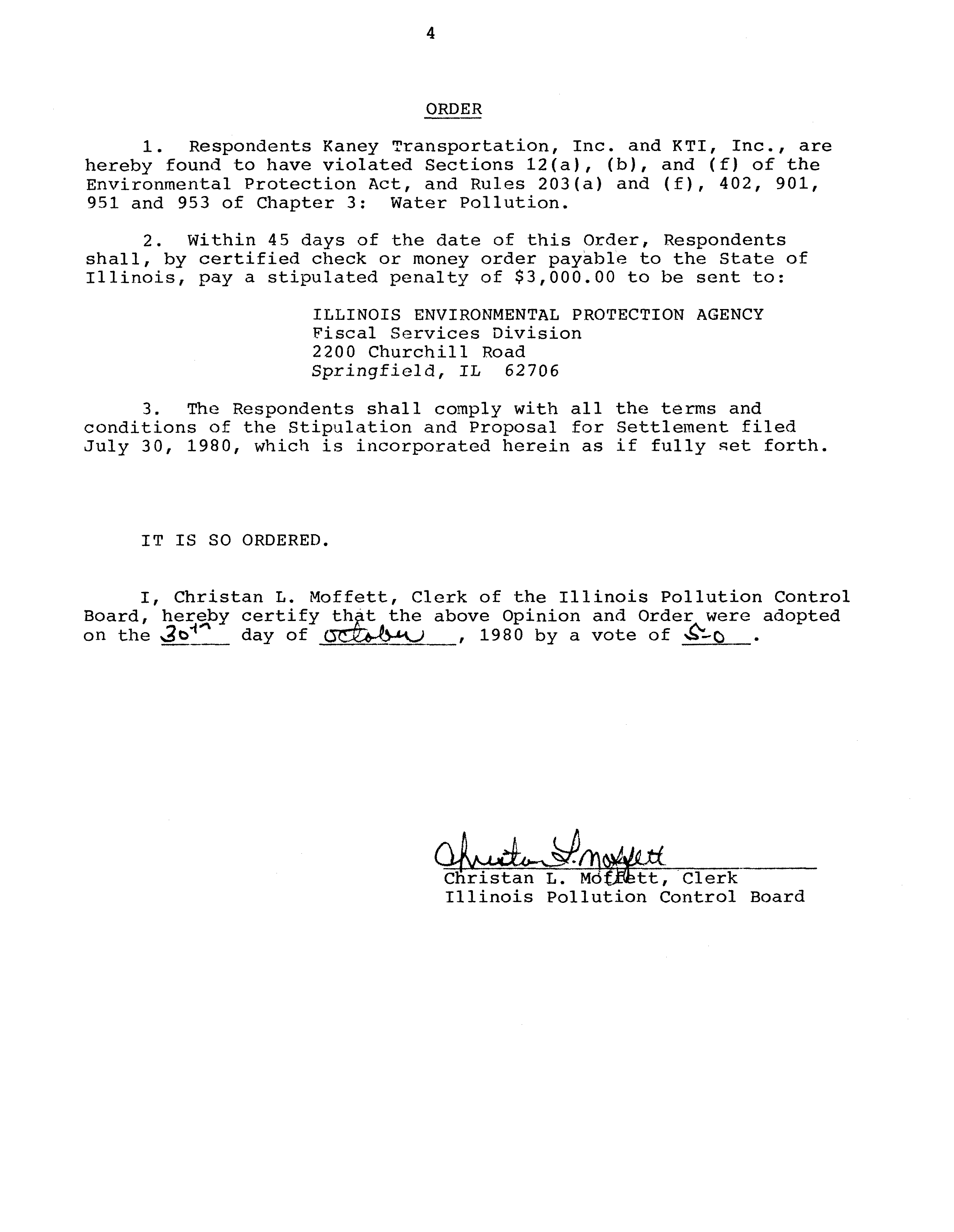ILLINOIS POLLUTION CONTROL BOARD
October 30, 1980
ENVIRONMENTAL PROTECTION AGENCY,
Complainant,
v.
)
PCB 78—236
KANEY TRANSPORTATION,
INC.
and
KTI,
INC.
Respondents.
DOUGLAS
P. KARP, ASSISTANT ATTORNEY GENERAL, APPEARED ON BEHALF
OF COMPLAINANT.
FREDERICK
T. BRANDT AND CURTIS D. WORDEN OF CURTIS
D. WORDEN,
LTD.
APPEARED ON BEHALF OF RESPONDENTS.
OPINION AND ORDER OF THE BOARD
(by J.
Anderson):
This matter comes before the Board on the Complaint of five
Counts filed by the Environmental Protection Agency (Agency) on
August 30,
1978,
as amended April
19,
1979.
Respondents Kaney
Transportation,
Inc. and KTI,
Inc., both Illinois corporations,
were charged with several violations of the Environmental Pro-
tection Act
(Act) and of the Board’s Chapter 3:
Water Pollution
(Chapter 3)
regulations arising out of their truck washing
operations.
Hearing was held on this complaint on March 21,
1980 at which testimony of
3 citizens of Rockford as well
as of
the parties was received.
Following this hearing, the parties
developed
a Stipulation and Proposal for Settlement.
This
Stipulation was presented at a hearing held July 29,
1980, which
no members of the public attended,
and was filed with the Board
for review on July 30,
1980.
KTI,
Inc.
(KTI)
is
a holding company whose sole subsidiary
is Kaney Transportation,
Inc.;
the corporations both have the same
directors,
officers, and owners.
Kaney operates from a site in
the City of Rockford, Winnebago County.
The nature of Kaney’s
business
is the transportation of liquids and gasses in bulk.
These include gasoline, propane,
fuel oil,
asphalt,
resins,
varnishes and latexes
(Stip.
1—2).
The Complaint charges Kaney with
I) discharging wastewater
into a water of the state without an NPDES permit from October,
1977 to April,
1979
in violation of Sections 12(a),
(b) and
(f)
of the Act,
and Rule 901 of Chapter
3,
II) construction and
2
modification of an existing treatment works,
sewer, or wastewater
source without a construction permit from October,
1974 to April,
1979 in violation of Sections
(a)
and
(b)
of the Act and Rule 951,
III) violation of water quality standards for a) maximum concen—
trations of phenols and fluoride, and b) freedom from unnatural
sludge, bottom deposits,
floating debris, odors,
unnatural colors
and turbidity from April,
1972 until
April,
1979,
in violation of
Section 12(a) of the Act and Rules 203(a)
and
(f) and 402,
IV)
operation of a treatment works without a certified operator from
July,
1973 to April,
1979,
in violation of Section 12(a) of the
Act and Rule 1201,
and V) operation of a treatment works without
a permit from October,
1974 to April,
1979,
in violation of
Sections 12(a)
and
(b) of the Act and Rule 953.
The stipulated
facts “offered in support”
of these allegations are as follows,
except that the Board has referred to citizen witnesses by name.
From January,
1974 until approximately March,
1979 the interior
of the holding tanks of trucks carrying certain of the specified
substances, as well
as the trucks’ exterior were washed on the
Rockford site.
The washing process employed a special
“spinner”
device
(since removed from the site) and involved use of hot water,~
caustic soda and solvent.
A weekly average of 300 gallons of
wastewater was so generated.
Since
March,
1979, only the exterior
of trucks has been washed on—site, interior cleaning being contracted
for with commercial enterprises.
The amount of wastewater generated
by this exterior washing was not stipulated
(Stip.
1—3).
Wastewater generated by the cleaning process passed through
a floor drain in a maintenance building,
into an underground drain
pipe,
and finally into a holding lagoon about 100 yards south of
the building.
The lagoon, approximately 100 feet long,
100 feet
wide, and
8 feet deep,
is about 100 yards away from a stream (stream)
which is tributary to the south fork of Kent Creek, which is tributary
to the Rock River.
This stream flows into the privately—owned “Zander”
pond, about 1200 feet downstream from the lagoon,
enroute flowing
onto or adjacent to property owned by other citizens, including the
Traum family (Stip.
2—4,
Ex.
A,
B).
It
was stipulated that Kaney employees were to observe the
lagoon, and when it was full,
to pump the accumulated wastes into
a tank truck for hauling to and disposal by the Rockford Sanitary
District.
However,
sludge of a depth of 4-5 feet was allowed to
accumulate in the lagoon
(Stip.
2—3).
The unusually heavy and drifting snows
of the winters of 1976—
1977 and 1978-1979 inhibited the view of and access to the
lagoon by
Kaney employees (Stip.
2,
3).
Truck washing did not stop during
these winters.
Wastewater was allowed to flow into and onto the
lagoon beneath the drifted snow.
In February, 1977 and 1978 Kaney
President Robert Higgins noticed that wastes
from the lagoon had
overflowed into the adjacent Kaney cornfield.
Citizen witnesses
Vittore, Faulkner, and Traum testified that in February,
1977,
April,
1978,
and on other unspecified occasions, they had each
3
observed wastes overflowing
the
lagoon, draining across the corn-
field,
and discharging into the stream.
Each also testified that
the stream bearing Kaney waste passed through, or by their downstream
properties.
The liquid waste was said to have
a reddish,
rusty,
oily color which discolored the stream and caused it to give off
unpleasant,
sickening odors
(Stip.
5-6)
and otherwise to have
created a nuisance.
Agency witness Jack Adam verified the testimony concerning
existence of overflows and downstream stream and pond discoloration
on February 22—23, 1977 and April
25,
1978.
He additionally ob-
served direct Kaney discharges into the ground on the April date.
Analyses of samples collected by Mr. Adam on each date showed
phenols
in excess of 0.1 mg/i
(Ex.
C—O)
and fluoride in excess
of 1.4 mg/l
(Ex.
L—O)
(Stip.
6—7).
Finally, Kariey specifically admitted to having operated the
lagoon without an operating permit or certified operator, and to
have raised the level of the south rim of the lagoon in fall,
1978
without obtaining a construction permit.
The parties’ proposed settlement would require Respondents’
to
“immediately,
if it has not already been done,” dredge and scrape
the lagoon and
to
properly dispose of all wastes and contaminated
soil,
if such has not already been done.
Thereafter,
continued
scraping and soil sampling of the lagoon floor is to continue until
concentrations of enumerated pollutants do not exceed background
levels.
Once these levels are met, Respondents are to submit a
lagoon design and applications for necessary permits,
to modify
the lagoon in specified ways once the permit is granted, and
thereafter to operate the lagoon in proper fashion.
The parties
have stipulated to payment of a penalty of $3,000.
The Board finds,
based on the facts
stipulated as developed
at hearing, that Kaney and KTI have violated the Act and Chapter
3 as
alleged in the Complaint through and until July 29,
1980.
The compliance program as developed by the parties is satisfactory
to the Board.
In considering the stipulated penalty in light of Section 33(c),
the Board
notes the high degree of injury to and interference with
the use enjoyment of the property of downstream land owners.
However,
in view of the fact that Kaney discontinued interior truck washing
a month before this enforcement action was brought,
arid
that some
of the problems were brought about by severe winter weather con-
ditions,
the Board will approve
the
penalty of $3,000.
The Board
therefore finds the Stipulation and Proposal for Settlement accep-
table pursuant to Procedural Rule 331 and Section 33(c)
of the Act.
This Opinion constitutes the Board’s findings of fact and
conclusions of law in this matter.
4
ORDER
1.
Respondents Kaney Transportation,
Inc. and KTI,
Inc., are
hereby found to have violated Sections 12(a),
(b), and
(f) of the
Environmental Protection Act, and Rules
203(a) and
(f),
402,
901,
951 and 953 of Chapter
3:
Water Pollution.
2.
Within 45 days of the date of this Order, Respondents
shall, by certified check or money order payable to the State of
Illinois, pay a stipulated penalty of $3,000.00 to be sent to:
ILLINOIS ENVIRONMENTAL PROTECTION AGENCY
Fiscal
Services Division
2200 Churchill
Road
Springfield,
IL
62706
3.
The Respondents
shall comply with all the terms and
conditions of the Stipulation and Proposal for Settlement filed
July 30,
1980,
which is incorporated herein as if fully ~et forth.
IT IS SO ORDERED.
I, Christan L. Moffett,
Clerk of the Illinois Pollution Control
Board,
hereby certify th~tthe above Opinion and Order were adopted
on the
..3b~
day of
~
1980 by a vote of
~—cj
Christan L.
Mc~.L1~tt,Clerk
Illinois Pollution Control Board




